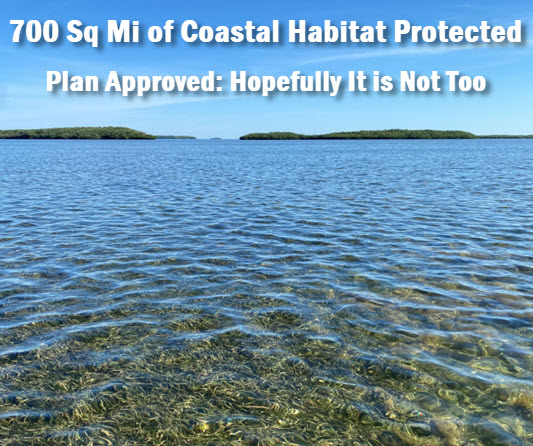700 Square Miles of Coastal Habitat Being Protected off Florida’s West Coast
April 14, 2023 08:55 am

 FLORIDA –
Florida's newest aquatic preserve is
officially set to move forward with a
management plan aimed at protecting
350,000 acres of seagrass, almost 10,000
acres of salt marsh, 121 acres of mangrove
swamp, and archaeological and cultural
sites.
FLORIDA –
Florida's newest aquatic preserve is
officially set to move forward with a
management plan aimed at protecting
350,000 acres of seagrass, almost 10,000
acres of salt marsh, 121 acres of mangrove
swamp, and archaeological and cultural
sites.
The Nature Coast Aquatic Preserve off Florida's west coast is the first new preserve designated in more than 30 years and part of the largest seagrass bed in the Gulf of Mexico. The Florida Department of Environmental Protection has approved a plan to protect the 700 square miles of coastal habitat along Citrus, Hernando, and Pasco counties.
Oveview: The Nature Coast Aquatic Preserve
The Nature Coast Aquatic Preserve was designated in the summer of 2020, adding over 450,000 acres of submerged public resources to Florida's Aquatic Preserve Program. The Preserve spans three counties of Florida’s Gulf of Mexico coastline.
Historically these waters were not formally managed by a single entity. Local stakeholders and researchers worked to gain knowledge of the unique features this area offers. The plan expands on these efforts and outlines ambitious goals for the years ahead.
The execution of the plan will guide managers to obtain a better understanding of the resources ensuring the preservation and protection of submerged communities and water resources that affect them.
Through partnerships and science-based monitoring, comprehensive data collection will be used to draft impactful solutions and disseminate accurate data to the Nature Coast community on the natural communities and human-related activities impacting the preserve.
The plan's primary focus is minimizing impacts on the resources while promoting sustainable use.
William Toney, a fishing guide in Homosassa, said he is not a political person, but spent years attending meetings to fight for his livelihood and the health of the Gulf.
"It really meant a lot to me and to the people in our communities here," Toney emphasized. "Especially us that make a living on the water, you know, we need that protection of our seagrass for all our fish and crabs and shrimp."
Toney pointed out economies of the towns connected to the preserve are mostly driven by tourism and fishing. The state management plan calls for routine water quality testing, restoring damaged sea grass, and encouraging community groups to work together. The preserve is now the 42nd in the Florida system.
The areas encompassing the preserve are home to mangrove islands, salt marshes, oysters, sponges, corals, and more. The plan allows for recreational activities like boating, fishing, and scalloping.
Joy Hazell, extension agent for the University of Florida/IFAS Extension, said locals saw the need to protect their own.
"The community went to the state government and said, 'We want to protect this,' " Hazell explained. ”When you have those community-driven resource protections, you just have a stronger agreement between the people who use the resource and the people who are in charge of managing the resource."
Community members cited increasing threats from pollution as part of their concerns. Recent bouts of red tide and other harmful algae blooms, fueled by farm and fertilizer runoff, dominated headlines, taking a toll on marine life and tourism businesses.
---------
This piece was reprinted by the Columbia County Observer with permission or license. It may not be reproduced in any form without permission or license from the source. Graphics, layout, and sidebar added by the Observer.

